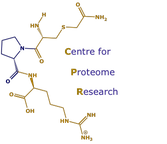Of mice, mups and mass spectrometry
Robert J. Beynon, Stuart D. Armstrong, Amy J. Claydon, Amanda J. Davidson, Claire E. Eyers, James I. Langridge, Guadalupe Gómez-Baena, Victoria M. Harman, Jane L. Hurst, Victoria Lee, Lynn McLean, Rebecca Pattison, Sarah A. Roberts, Deborah M. Simpson, Jenny Unsworth, Matthias Vonderach, Jonathan Williams and Yvonne E. Woolerton (2015) Mass spectrometry for structural analysis and quantification of the Major Urinary Proteins of the house mouse. Int J. Mass Spectrometry
Abstract
The Major Urinary Proteins (MUPs) of the house mouse, Mus musculus domesticus, are 19 kDa beta-barrel lipocalins that are involved in chemical communication between individuals. Many of them are excreted in urine where they play multiple roles, including coding of owner identity and transport, and slow release of bound volatile pheromones. One of them, darcin, is a pheromone in its own right and induces long-term memory for the identity and location of the scent mark owner. We have shown that mass spectrometric analysis of intact proteins, and their ion mobility behaviour, is capable of dissecting subtle structural differences between the members of this class of proteins. Moreover, mass spectrometric analysis of the intact proteins can contribute towards molecular phenotyping of MUPs. However, whilst allowing relative quantification, the ionisation propensity or gas phase properties of the individual MUPs may compromise absolute quantification,. To solve the challenge of absolute quantification of MUP expression, we have designed and constructed a QconCAT built from endopeptidase LysC peptides that is capable of quantifying MUPs found in laboratory animal strains and some MUPs from wild caught individuals.
Highlights
• Major Urinary Proteins retain folded conformations as gas phase ions under conditions of electrospray ionisation at low or neutral pH values.
• Individual MUPs vary in their gas phase stability, despite modest differences in primary sequence and three dimensional structure.
• The disulphide bond in one of these proteins, darcin, is critical to its pronounced stability.
• Variation in gas phase behaviour means that quantification of individual MUPs by intact mass phenotyping is restricted to relative quantification.
• A QconCAT approach can be used to address individual MUP absolute quantification, and to solve the ‘isoform problem’ for this group of proteins.
Abstract
The Major Urinary Proteins (MUPs) of the house mouse, Mus musculus domesticus, are 19 kDa beta-barrel lipocalins that are involved in chemical communication between individuals. Many of them are excreted in urine where they play multiple roles, including coding of owner identity and transport, and slow release of bound volatile pheromones. One of them, darcin, is a pheromone in its own right and induces long-term memory for the identity and location of the scent mark owner. We have shown that mass spectrometric analysis of intact proteins, and their ion mobility behaviour, is capable of dissecting subtle structural differences between the members of this class of proteins. Moreover, mass spectrometric analysis of the intact proteins can contribute towards molecular phenotyping of MUPs. However, whilst allowing relative quantification, the ionisation propensity or gas phase properties of the individual MUPs may compromise absolute quantification,. To solve the challenge of absolute quantification of MUP expression, we have designed and constructed a QconCAT built from endopeptidase LysC peptides that is capable of quantifying MUPs found in laboratory animal strains and some MUPs from wild caught individuals.
Highlights
• Major Urinary Proteins retain folded conformations as gas phase ions under conditions of electrospray ionisation at low or neutral pH values.
• Individual MUPs vary in their gas phase stability, despite modest differences in primary sequence and three dimensional structure.
• The disulphide bond in one of these proteins, darcin, is critical to its pronounced stability.
• Variation in gas phase behaviour means that quantification of individual MUPs by intact mass phenotyping is restricted to relative quantification.
• A QconCAT approach can be used to address individual MUP absolute quantification, and to solve the ‘isoform problem’ for this group of proteins.
